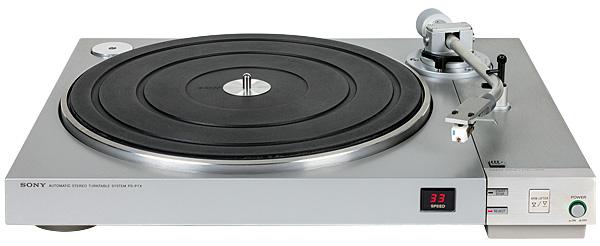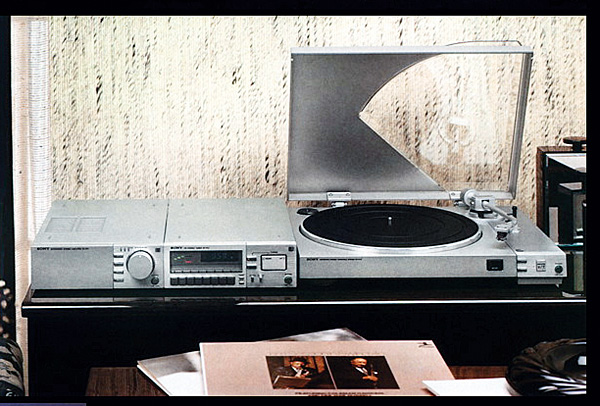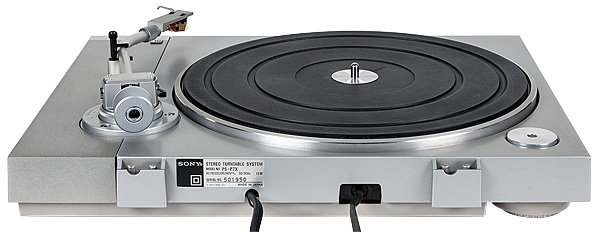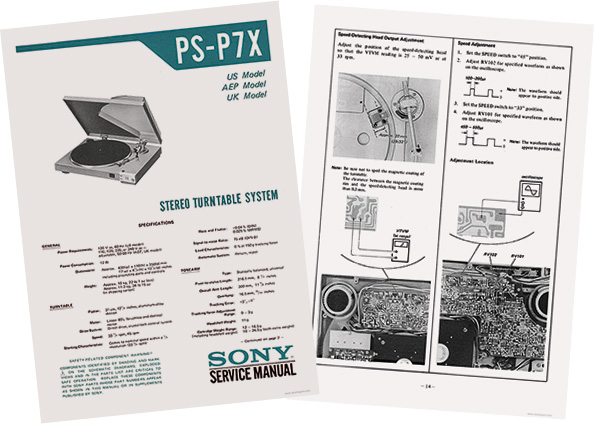Sony PS-P7X turntable

 Launched in the late '70s as part of a new wave of shoebox-sized systems from Japan, this elegant deck packed plenty of groundbreaking tech. How does it perform today?
Launched in the late '70s as part of a new wave of shoebox-sized systems from Japan, this elegant deck packed plenty of groundbreaking tech. How does it perform today?
It wasn't until the 1970s that the LP reached its heyday. By then, most albums were stereo and the equipment needed to play them was widely available. In 1975, Mike Oldfield's Tubular Bells hit the high watermark for vinyl sales, confirming the format's dominance. At the time, most people still only had 'record players' – all-in-one turntables, amplifiers and speakers – but this was the peak of the decade's hi-fi boom, and people were scrambling to get their hands on proper, grown-up, stereo systems.
It was to these buyers that Japanese brands appealed. The equipment wasn't cheap, but it was still affordable – and made to a reasonably high standard. As ABBA, The Bee Gees and 10cc dominated the pop charts, a hi-fi system was the third largest purchase a typical family would make after a house and a car, no less.

Stack Exchange
It is hard to overstate just how dramatically hi-fi evolved during this dynamic decade. At its beginning the products that most people could afford were pretty mediocre – noisy turntables, low powered solid-state amplifiers and far from neutral speakers. Aesthetically and ergonomically a mish-mash, most mass-market stereos looked like a random assemblage of bits that happened to be on the local dealer's shelf when the prospective purchaser walked into the showroom. By the end of the decade, however, things had changed dramatically. So-called rack systems were now de rigueur for the mass market, and comprised big, chunky, matching separates that looked expensive and had a quality feel at least – if not always a quality sound.
At the end of the '70s, there was a sudden move to downsize and to streamline. Large stack systems rapidly became passé, and soon less was more. Toshiba's System 15, launched in 1978, really changed the direction of travel. It was a tiny stacking system that packed as much power and functionality as pretty much any grown-up alternative. The result was that practically every other mainstream Japanese manufacturer followed suit, and soon there were similar models from Technics, Mitsubishi, Hitachi, Aiwa and Pioneer reaching British shores.
Sony's version was called Precise, and it is from this range that the PS-P7X you see here is taken. A compact turntable designed to match the half-sized TA-P7F integrated amplifier and ST-P7J FM tuner, this £220 deck packed cutting-edge tech with fine build quality and great sound.
Crystal Control
Unveiled in Japan in the autumn of 1978, the deck was a dramatic contrast to the sort of turntables Sony was selling as recently as five years earlier. Indeed it shows the amazing speed at which the company was advancing during the period.

In the early '70s the default for Japanese vinyl spinners was a belt-driven design with an integrated tonearm of high-ish mass, a wood or wood-look plastic plinth and smoked dustcover, and automation that was clunky and/or clumsy. Compare that to the fully automatic quartz-locked direct drive PS-P7X of the late '70s, with its beautiful cast alloy plinth, sculpted top, microswitch-activated power cueing and a beautifully precise feel, and the contrast is like night and day.
The Sony PS-P7X also happened to be easy to use and far more compact than many rivals. It raised the bar for ergonomic, electronic and mechanical sophistication in a single and rather elegant package. Arguably only Technics' radical parallel-tracking SL-10 did better – and that's really saying something. Decks such as this made the process of spinning LP records feel effortless yet highly rewarding. Forty years later, nothing in the vinyl world has come along to make the PS-P7X seem crude to use, and only the invention of Compact Disc made it appear slightly cumbersome.
By the time the PS-P7X hit the shops, Sony had only been making mainstream direct-drive decks for five years – and only then towards to the top of the company's large turntable range. Yet this had been sufficient for engineers to refine its brushless, slotless linear motor to a very high level – here it offers a vanishingly low quoted wow and flutter figure of 0.025% [see PM's Lab Report]. By the standards of the day this was staggering. Not even the British reference 'superdeck' of that time – Linn's LP12 – achieved such levels of speed accuracy. This was down to Sony's excellent implementation of crystal-referenced speed control, which used a 'Magnedisc' tape head reading pulses on the inside edge of the platter. With this real-time reference, the speed control circuitry could govern the motor torque, keeping rotation constant.

Many hi-fi purists still labour under the misapprehension that Japanese direct drives of this era are flimsy, plasticky things. This was certainly true of budget models from the period, but the expensive Sony's plinth is a work of art. Unlike most of today's turntables, which have plinths made out of some variant of painted or coated fibreboard, the PS-P7X's is a combination of Sony's Bulk Mould Compound for the chassis, allied to an elaborate aluminium diecasting. The whole assembly sits on adjustable, vibration absorbing fluid-filled rubber feet. The overall effect is of a substantive 10kg 'suspended mass', in a fairly compact 430x110x350mm (whd) package.
Careful attention to detail was paid to the positioning of the power supply and associated motor drive circuitry, and the result is a superb quoted signal-to-noise ratio of 75dB. The 310mm diecast aluminium alloy platter has a decent quality rubber mat that offers good record support, damping the platter down further.
Feather Touch
Operationally, the deck is a breeze to use. The statically balanced J-shaped tonearm has an effective length of 216.5mm and 16.5mm overhang, and a lovely action when being hand-cued. It sports a beautiful matt metal finish to its zinc-alloy armbase, and a good quality SME-style locking aluminium headshell, permitting a cartridge weight range of 12g to 24.5g (with the addition of an extra balance weight to the end of the counterweight).


















































